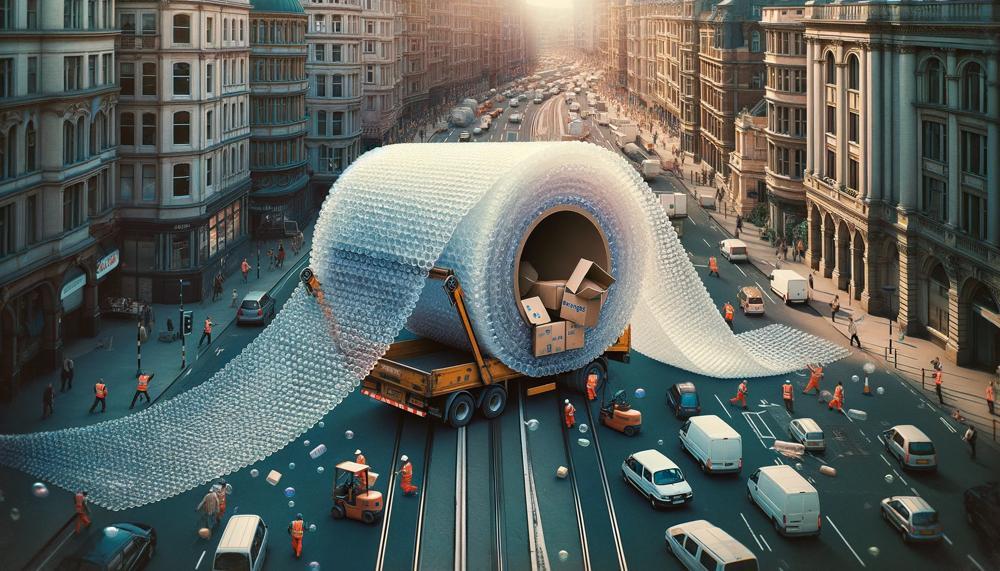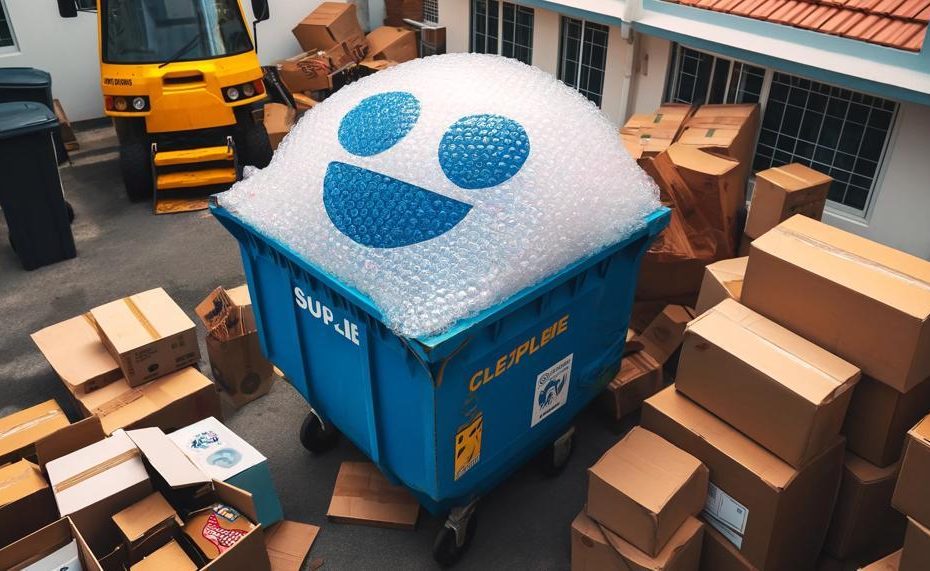Did you know that over 300 million square feet of bubble wrap is produced every year in the United States alone, but a large portion of it ends up in landfills due to improper disposal? This eye-opening statistic highlights the pressing need to handle this popular packaging material responsibly.
So, how to dispose of bubble wrap properly?
Bubble wrap is made from low-density polyethylene film (LPDF), which is a type of soft plastic. It’s important to note that bubble wrap cannot be recycled in the same way as other plastics like soda bottles or cardboard. Here’s how you can dispose of bubble wrap properly:
- Pop all of the air bubbles: This is the first step before recycling bubble wrap.
- Separate from other plastics: Bubble wrap should be separated from hard plastics and put together with other soft plastics.
- Find a recycling center: Bubble wrap needs to be taken to a special drop-off location or a recycling center that accepts plastic films. You can usually find a location on your city’s waste management website.
- Store drop-off locations: Many chain stores like Target and Walmart have guest recycling stations at the front of the stores that are available for drop-offs.
Navigating the complexities of bubble wrap disposal isn’t just about throwing things away; it’s about making informed decisions that benefit both our immediate environment and the global ecosystem.
By the end of this introduction, you’ll have a clearer understanding of how to dispose of or repurpose your bubble wrap in ways that contribute positively to environmental sustainability.
Whether you’re a regular online shopper or a small business owner, mastering the art of bubble wrap disposal is a crucial skill in today’s eco-conscious world.
Contents
- 1 How to Dispose of Bubble Wrap
- 2 Best Option – Reuse the Bubble Wraps
- 3 Post Bubble Wrap Online
- 4 Donate Bubble Wrap In Person
- 5 Recycle Bubble Wrap
- 6 For Businesses – Partner With a Waste and Recycling Company
- 7 Benefits of Recycling and Reusing Bubble Wrap
- 8 Worst Option – Put It In The Garbage
- 9 Most Popular Articles
- 10 Conclusion
How to Dispose of Bubble Wrap
When considering environmentally-friendly disposal methods for bubble wrap, here’s a structured guide on how to proceed:
| Method | Description | Benefit |
| Reuse | Utilize in home for protective or creative uses. | Reduces waste, saves energy. |
| Donate | Give to individuals or institutions that can reuse it. | Extends usability, avoids landfills. |
| Community Exchange | Post on platforms like Craigslist. | Finds local users, promotes community sharing. |
| Retail Drop-off | Drop at stores accepting donations. | Ensures continued protective use. |
| Recycle | Take to a specialized recycling center. | Prevents pollution, conserves resources. |
Key Consideration: Always verify the acceptance of plastic films for recycling as not all centers have the facilities to process them.
Best Option – Reuse the Bubble Wraps
| Use in Gardening | Wrap bubble wrap around plant pots to insulate them during colder months. This helps protect delicate roots from frost. |
| Home Insulation | Use bubble wrap as an inexpensive insulator for windows. Attach it to the inside of your window panes during the winter to help reduce heat loss. |
| Protective Packing | Reuse bubble wrap for personal shipping needs or when moving. It’s perfect for wrapping breakables like dishes and glassware. |
| Craft Projects | Transform bubble wrap into art. Use it as a stamp by painting on it and pressing it onto paper, or use it to add texture to clay or plaster projects. |
| Stress Relief | Keep a sheet of bubble wrap handy for popping. It’s a fun, tactile way to relieve stress and can be surprisingly therapeutic. |
| Drawer Liners | Use bubble wrap to line drawers and shelves, providing a non-slip surface while also protecting the contents. |
| Recreation | Create a bubble wrap runway for kids’ playtime. It’s a safe, cushioned surface that provides sensory feedback. |
In reimagining bubble wrap beyond its traditional use, we discover it as a versatile and valuable resource in households. From insulating plant pots and windows to reinvigorating crafts, bubble wrap offers both practical and playful solutions.
It’s not just for protecting goods; it’s an imaginative tool ready to be repurposed, ensuring you make the most of this lightweight, air-filled material.
Post Bubble Wrap Online
Answer: To effectively dispose of bubble wrap through online posting, consider leveraging platforms dedicated to reuse and donation, such as Craigslist, Freecycle, or local Facebook community groups.
These platforms allow you to connect with individuals or organizations that could benefit from your surplus bubble wrap, promoting an eco-friendly disposal method. Below are detailed steps and considerations for posting your bubble wrap online:
| Platform | Advantages | How to Post |
| Craigslist | Wide reach, quick responses | List in the “Free” section with clear photos and details |
| Freecycle | Eco-conscious community | Create a post focused on reuse and environmental care |
| Facebook Groups | Local community engagement | Use community groups; include location for local interest |
Donate Bubble Wrap In Person
Donating bubble wrap in person is a straightforward and eco-friendly method to ensure it continues to serve a useful purpose.
The process involves identifying local businesses or community centers that accept such materials for reuse, thereby extending its life and minimizing environmental impact.
Steps to Donate Bubble Wrap In Person:
- Clean the Bubble Wrap: Ensure that the bubble wrap is free from any adhesive labels, dirt, or moisture. Clean materials are more likely to be accepted for reuse.
- Identify Local Recipients: Contact local shipping stores, charity shops, or community centers. Many of these places welcome packing materials for their daily operations.
- Drop Off the Material: Once a recipient is confirmed, take the bubble wrap to the location. Ensure it’s neatly folded or rolled to facilitate easy storage and reuse by the recipient.
Table of Local Options:
| Recipient Type | Examples | Contact Method |
| Shipping Stores | UPS, FedEx | Call local store |
| Charity Shops | Goodwill, Salvation Army | Visit nearest location |
| Community Centers | Local community halls | Email or visit |
Additional Considerations:
- Confirm Acceptance: Before transporting your bubble wrap, confirm that the location accepts such donations to avoid unnecessary trips.
- Regular Donations: If you frequently have excess bubble wrap, consider setting up a regular donation schedule with a local business that can utilize it consistently.
Recycle Bubble Wrap
To ensure bubble wrap is recycled properly, here’s a detailed guide using practical steps and tips. Each stage of this process contributes to the efficient handling of this material:
| Step | Action | Details |
| 1 | Identify Type | Confirm that your bubble wrap is plastic film and not a composite material. |
| 2 | Prepare for Recycling | Gently pop all bubbles to reduce volume and prevent machine damage at recycling facilities. |
| 3 | Local Drop-off Search | Use resources like the Green Directory to find nearby drop-off locations that accept bubble wrap. |
| 4 | Separation | Ensure bubble wrap is clean and free from tape and labels; separate from other plastics. |
| 5 | Drop-off | Take the prepared bubble wrap to the designated recycling center or drop-off location. |
| 6 | Alternative Uses | If recycling options are limited, consider reusing for personal packing needs or donate to local businesses. |
For Businesses – Partner With a Waste and Recycling Company
For businesses aiming to enhance their environmental practices, particularly in the disposal of bubble wrap, partnering with a specialized waste and recycling company provides several compelling benefits. This approach aligns with a sustainable business model while addressing the logistical and environmental challenges associated with waste management.
- Cost Efficiency: By collaborating with a recycling provider, businesses can reduce waste disposal costs. Efficient recycling processes often include the collection and resale of processed materials, such as bubble wrap, which can potentially offset the costs of recycling services.
- Compliance and Liability: Recycling companies ensure compliance with local and national environmental regulations, helping businesses avoid legal penalties associated with improper disposal practices. This is particularly pertinent for materials like bubble wrap, which require specific handling to be recycled properly.
- Enhanced Reputation: Adopting environmentally responsible practices through partnerships with recycling firms can boost a company’s image. Customers and clients are increasingly drawn to businesses that demonstrate a commitment to sustainability.
- Resource Management: Waste and recycling companies provide expertise in managing recyclable materials. They can offer businesses tailored solutions for the effective sorting, collection, and recycling of bubble wrap, ensuring that these materials are handled efficiently.
- Environmental Impact: Proper disposal and recycling of bubble wrap contribute significantly to reducing the environmental footprint of a business. This includes lessening landfill use, decreasing plastic pollution, and conserving resources used in the production of new plastic products.
Benefits of Recycling and Reusing Bubble Wrap
Recycling and reusing bubble wrap, rather than simply discarding it, can significantly amplify environmental conservation efforts.
The following details encapsulate the primary environmental benefits:
Reduces Waste in Landfills
Bubble wrap is not biodegradable, taking anywhere from a decade to a millennium to break down in landfills.
By recycling and reusing this material, we can notably diminish the volume of waste accumulating in landfills.
Conserves Resources
Recycling bubble wrap mitigates the need to produce new materials. This conservation of resources leads to a reduction in the consumption of raw materials such as petroleum, which is essential for making plastic.
Energy Conservation
The process of recycling plastics, including bubble wrap, typically consumes less energy compared to producing new plastic materials from scratch.

This energy efficiency translates to lower carbon emissions.
Reduces Greenhouse Gas Emissions
By lowering the amount of waste that decomposes in landfills, recycling and reusing bubble wrap cuts down on methane emissions.
Methane is a potent greenhouse gas that significantly contributes to global warming.
Encourages Sustainable Practices
Promoting the recycling and reuse of bubble wrap fosters a culture of sustainability and responsible waste management.
It highlights the importance of rethinking how materials are used and encourages innovative uses beyond initial purposes.
Environmental Impact Table
Here’s a comparative analysis of the environmental impact of recycling versus disposing of bubble wrap:
| Aspect | Recycling Bubble Wrap | Disposing of Bubble Wrap |
| Waste Reduction | Significant reduction in landfill waste | Contributes to landfill mass and potential environmental hazards |
| Resource Conservation | Decreases demand for new raw materials | Increases demand for new raw materials, depleting resources |
| Energy Consumption | Lower energy use in recycling process | Higher energy use in manufacturing new products |
| Emissions | Reduces greenhouse gases by decreasing methane from landfills | Increases greenhouse gases from new material production and waste decomposition |
| Sustainability Promotion | Supports sustainable practices and innovation in reuse | Perpetuates a single-use mindset and wasteful practices |
Worst Option – Put It In The Garbage
Disposing of bubble wrap in the garbage is widely regarded as the poorest choice due to its significant environmental repercussions.
When bubble wrap ends up in the garbage, it invariably makes its way to landfills or, worse, into marine environments, where it contributes to pollution and poses a hazard to wildlife.
Here’s a detailed look at the implications:
- Non-Biodegradable: Bubble wrap is made primarily of plastic materials which do not biodegrade. This results in prolonged environmental presence, leading to increased waste in landfill sites.
- Marine Pollution: Discarded bubble wrap can easily end up in oceans, where it fragments into microplastics, widely consumed by marine life, thereby entering the food chain.
- Resource Waste: Throwing bubble wrap away squanders the potential for reuse or recycling, missing opportunities to conserve resources and energy.
- Toxicity: As bubble wrap decomposes over many years, it potentially releases harmful chemicals into the environment, impacting soil quality and groundwater.
The table below outlines the comparison of disposing of bubble wrap via garbage versus more sustainable methods:
| Disposal Method | Impact on Landfills | Environmental Safety |
| Garbage | Increases landfill mass | Poor – Leads to pollution and wildlife risk |
| Reuse/Recycle | Reduces landfill contribution | Good – Lowers environmental hazards |
| Donation | Prevents landfill addition | Excellent – Promotes sustainability |
Given these points, it is clear that disposing of bubble wrap by simply throwing it in the garbage should be avoided whenever possible.
Most Popular Articles
To dispose of bubble wrap in ways that are kind to our planet, a few effective methods stand out. Here’s a detailed exploration:
- Recycling: Bubble wrap, crafted from polyethylene, can be recycled. For successful recycling:
- Ensure the bubble wrap is clean and free from adhesives like tape or labels.
- Check with your local recycling centre regarding their acceptance and preparation guidelines.
- Reusing: Given its durability, bubble wrap can be reused several times before it becomes ineffective. Here’s how you can maximize its use:
- Retain any bubble wrap from packages you receive.
- Reuse it for your own shipping needs or when storing fragile items.
- Biodegradable Options: Opt for biodegradable bubble wrap made from materials like cornstarch, which decompose naturally without harming the environment. Proper disposal methods must still be followed.
- Donation: Donate bubble wrap to local businesses or charitable organizations that require packaging materials but might not afford new supplies.
Conclusion
Bubble wrap, ubiquitous in shipping and packaging, presents unique challenges and opportunities when considering disposal. Producing over 300 million square feet annually in the U.S. alone, it is crucial to adopt methods that prevent this material from saturating landfills and harming the environment.
- Reuse and Repurpose: Firstly, reusing bubble wrap at home for various purposes not only mitigates waste but also promotes creative reuse, from insulating windows to crafting engaging art projects. Sharing or donating to those who can find a second life for it turns bubble wrap from potential waste into a valuable resource.
- Recycling: If reuse is not an option, recycling becomes the next best step. Locating facilities that accept plastic films can be challenging, but efforts to separate and clean bubble wrap before recycling help ensure that it is processed correctly, preventing contamination at recycling sites.
- Community Engagement: Engaging with local recycling programs and platforms like Craigslist or Freecycle can amplify the impact of recycling efforts, fostering a community-oriented approach to sustainability.
To navigate this path effectively, awareness and proactive participation are essential. Each step taken in properly disposing or repurposing bubble wrap not only addresses the immediate handling of waste but also contributes to a broader movement towards sustainability.





